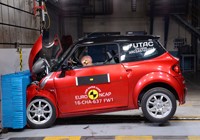Quadricycle Safety at a Standstill
6th April 2016
Brussels, Euro NCAP continues its assessment of heavy quadricycles and today releases the safety ratings of four such vehicles. The organisation has studied what has changed in this segment in the last two years and has introduced a specific star rating for these vehicles to help consumers in their purchase decision. Safety equipment is sparsely fitted to these vehicles and the results show little improvement since the last tests performed in 2014.

The crash test results of the selected vehicles - Aixam Crossover GTR, Bajaj Qute, Chatenet CH30 and Microcar M.GO Family - show that there are still fundamental problems with this segment. All four vehicles have been assessed using the same protocols that were used in 2014 when testing the first quadricycles. While some vehicles perform better than others, the standard of protection offered to the driver is still generally very low, leading to serious risks in collisions with other vehicles or obstacles.
Euro NCAP’s first tests on heavy quadricycles showed major shortcomings in safety. The organisation called for more realistic requirements from the regulators and for quadricycle manufacturers to take more responsibility for the safety of their products. Since then, more quadricycles have come onto the market and an updated European regulation has come into force, leading Euro NCAP to revisit the safety offered in this segment, with the support of Global NCAP in partnership with the Bloomberg Initiative for Global Road Safety.
Euro NCAP Secretary General, Dr Michiel van Ratingen, said: ‘It is disappointing to see that quadricycles are still lacking basic safety features that are common in small cars. By not challenging the manufacturers to do more, legislators continue to give a false impression to consumers that these vehicles are fit for purpose.’
The latest results show that little progress has been made, with test findings that are as bad as two years ago. The Microcar M.GO by Ligier is the only to be fitted with a driver airbag as an option but tests show this to be ineffective. With no improvement in structural integrity, the airbag offers no increase in protection and appears to be little more than a marketing ploy.
Quadricycles are still not subject to the same legislation as passenger cars. Nevertheless, these vehicles look like small city cars and are likely to compete for sales. However, their performance in Euro NCAP’s tests is far below a similarly-sized passenger car which can be bought second-hand more cheaply. Van Ratingen to add: ‘Simple design changes could lead to significant improvements, with little added weight or cost. Pursuing an environmental agenda is not an excuse for unsafe vehicles. Therefore Euro NCAP again calls for safety to be prioritised for heavy quadricycles.’
David Ward, Director General of Global NCAP said, ‘Euro NCAP and Global NCAP are working in partnership to help draw policymaker and consumer attention to this category of badly performing and poorly regulated vehicles. Quadricycles have significant potential for sales in markets across the world and it’s essential that minimum safety standards are put in place and that consumers are made aware of their safety shortcomings, especially when compared with similarly sized passenger cars.’ Ward to add: ‘We will be urging action on quadricycle safety through effective regulation in the UN World Forum for Harmonisation of Vehicle Regulations.’
Pictures and videos and report of all the quadricycles tested are available on our website and Media Center. For media information, please contact Marie Brasseur, Euro NCAP Communications Manager at Marie_Brasseur@euroncap.com.
Comparison table of the 2016 and 2014 quadricycles’ results and of the Toyota IQ tested under similar conditions*.
| Model | Year | Front Score | Side Score | Percentage | Stars |
| Toyota iQ | 2016 | 12 out of 16 | 12 out of 16 | 75% | 5 stars |
| Aixam Crossover GTR | 2016 | 2 out of 16 | 10 out of 16 | 25% | 1 star |
| Bajaj Qute | 2016 | 4 out of 16 | 6 out of 16 | 28% | 1 star |
| Chatenet CH30 | 2016 | 6 out of 16 | 6 out of 16 | 38% | 2 stars |
| Microcar M.GO Family | 2016 | 4 out of 16 | 6 out of 16 | 28% | 1 star |
| Club Car Villager 2+2 LSV | 2014 | 2 out of 16 | 9 out of 16 | 23% | 0 star |
| Ligier IXO JS Line 4 | 2014 | 2 out of 16 | 8 out of 16 | 22% | 0 star |
| Renault Twizzy | 2014 | 6 out of 16 | 7 out of 16 | 39% | 2 stars |
| Tazzari ZERO | 2014 | 4 out of 16 | 8 out of 16 | 31% | 1 star |
* Euro NCAP has tested the Toyota iQ ‘microcar’ in identical test conditions as the quadricycles to highlight the differences between the quadricycle and passenger car categories. The official Euro NCAP rating of the iQ tested in 2009 can be found on our website.
About Global NCAP
Global NCAP is an independent UK registered charity serving as the global platform for new car assessment programmes worldwide. Global NCAP has consultative status with the United Nations (ECOSOC), is a member of the United Nations Road Safety Collaboration and the Bloomberg Initiative for Global Road Safety. Global NCAP supports the UN Global Goals and Decade of Action for Road Safety. The crash testing of quadricycles has been made possible through funding from Bloomberg Philanthropies. Visit Global NCAP’s website